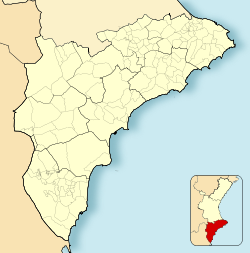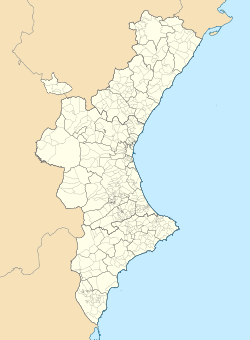
Back Guardamar del Segura AN غواردما ديل سيجورا Arabic جواردما ديل سيجورا ARZ Guardamar del Segura AST Qvardamar-del-Sequra Azerbaijani قواردامار دل سقورا AZB Guardamar del Segura Breton Guardamar del Segura Catalan Гуардамар-дель-Сегура CE Guardamar del Segura (munisipyo) CEB
Guardamar del Segura | |
|---|---|
 Guardamar Town Hall | |
| Coordinates: 38°5′23″N 0°39′18″W / 38.08972°N 0.65500°W | |
| Country | |
| Autonomous community | |
| Province | Alicante |
| Comarca | Baix Segura / Vega Baja |
| Judicial district | Torrevieja |
| Founded | 10th century |
| Government | |
| • Mayor | Carmen Verdú (2011) (PP) |
| Area | |
• Total | 35.58 km2 (13.74 sq mi) |
| Elevation | 25 m (82 ft) |
| Population (2018)[1] | |
• Total | 15,058 |
| • Density | 420/km2 (1,100/sq mi) |
| Demonym(s) | guardamarenc, -a (Val.) guardamarenco, -a (Sp.) |
| Time zone | UTC+1 (CET) |
| • Summer (DST) | UTC+2 (CEST) |
| Postal code | 03140 and 03149 |
| Dialing code | 965 and 966 |
| Official language(s) | |
Guardamar del Segura (Valencian: [ˌɡwaɾðaˈmaɾ ðel seˈɣuɾa]), or briefly Guardamar, is a municipality of the province of Alicante located at the mouth of the river Segura in southern Valencia (autonomous community), Spain. It is a Mediterranean resort, with a large pine forest abutting an 11-km-long white sand beach.
Historically, it was an area of fishermen and farmers. A Phoenician colony, called Herna by Roman geographer Avienius in his book Ora Maritima was the first settlement near the mouth of Segura river,[2] In Valencian, guardar means safekeeping and mar means sea, and this is another possible basis for its current name.
Guardamar is the southernmost Valencian-speaking town and in 1991 41.8% of the town's residents could speak it.[3] Guardamar is also the only municipality of the Vega Baja del Segura comarca (known locally as Baix Segura) where Valencian is traditionally and widely spoken.
Guardamar hosts local festivals like Moros i Cristians (Moros y Cristianos), L'Encantà, and Fogueres de Sant Joan (Hogueras de San Juan), which commemorate its history.
- ^ Municipal Register of Spain 2018. National Statistics Institute.
- ^ Bierling, Marilyn R. and Gitin, Seymour (2002). The Phoenicians in Spain: an archaeological review of the eighth-sixth centuries B.C.E.: a collection of articles translated from Spanish. Eisenbrauns, p. 124. ISBN 1-57506-056-6
- ^ "Fons estadístic documental - Generalitat Valenciana". www.edu.gva.es. Retrieved 20 April 2018.




